Rafayel Israyelian
Rafayel "Rafo" Israyelian[1][2] (Armenian: Ռաֆայել Իսրայելյան; 17 September [O.S. 4 September] 1908 – 8 September 1973) was an Armenian architect.
Rafayel Israyelian | |
|---|---|
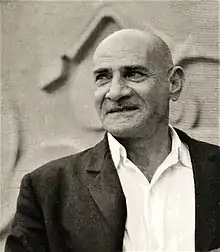 | |
| Born | 17 September [O.S. 4 September] 1908 Tiflis, Russian Empire |
| Died | September 8, 1973 (aged 64) Yerevan, Soviet Armenia, USSR |
| Nationality | Armenian |
| Occupation | Architect |
| Years active | 1936–1973 |
Notable work | List |
| Website | www |
Seen as a follower of Alexander Tamanian,[3] Israyelian designed some of Soviet Armenia's most prominent structures, including the Sardarapat Memorial, the Yerevan Wine Factory and several churches, both in Armenia and abroad, most notably St. Sargis in Yerevan and St. Vartan in New York.
Life
Israyelian was born in Tiflis (modern-day Tbilisi, capital of Georgia), then part of the Russian Empire, on 17 September [O.S. 4 September] 1908 to Armenian parents. His father, Sargis, was a philologist and folklorist born in Shusha (Shushi), Karabakh, while his mother, Mariam (née Hakhnazarian) was a teacher, originally from Nakhichevan.[4]
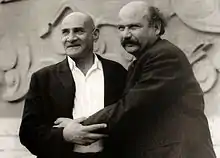
He attended an Armenian school in Tiflis and continued his education at the State Academy of Arts of Georgia, from which he graduated in 1928 as an architect. He later moved to Leningrad, where he studied at the Leningrad Institute of Communal Building from 1929 to 1932. He thereafter continued his education at the Ilya Repin Leningrad Institute for Painting, Sculpture and Architecture (formerly the Imperial Academy of Arts) until 1936.[4][6]
Israyelian moved to Yerevan, Soviet Armenia in 1936[7] and worked at different state-run architectural organizations. He taught at the Yerevan Polytechnic Institute from 1941 to 1963. During World War II, he served in an anti-aircraft defense unit based in Yerevan.[2] He received the title of a kandidat nauk from the Repin Leningrad Institute for Painting, Sculpture and Architecture in 1952.[4] Israyelian closely worked with the Armenian Apostolic Church, under Catholicos Vazgen I and was part of the architectural committee of the Mother See of Holy Etchmiadzin from 1956 to 1972.[5]
He died on September 8, 1973, aged 65, at his Yerevan home, after a long illness.[7][1]
Works
Israyelian was inspired by traditional Armenian architecture, especially church architecture. He utilized many traditional designs in his projects.[8] In this aspect, he is seen as a follower of the neoclassical architect Alexander Tamanian.[3][9] He also borrowed from the architecture of Mesopotamia (Sumer, Babylon, and Assyria).[3][10] However, his work is considered to be contemporary (modern).[3][11]
He extensively studied khachkars and his studies were published in Etchmiadzin magazine posthumously in 1977.[2][12]
Memorials
Israyelian created two memorials dedicated to the victims of the Armenian Genocide, when its 50th anniversary was commemorated in 1965. The better known monument is located at Mother See of Holy Etchmiadzin and was inaugurated on April 24, 1965. It features several crosses inspired by traditional khachkars and a sword and shield, symbolizing Armenian self-defense efforts during the genocide.[13] The second memorial is located Yerevan's Erebuni District. The latter was sculpted by Ara Harutyunyan.[14][5]
Israyelian's best-known memorial[15][11] is the Sardarapat Memorial, near Araks, Armavir, completed in 1968 and inaugurated on May 25 of that year.[16] It is dedicated to the 1918 Battle of Sardarabad, in which the Armenian forces stopped the advantage of Turkish forces towards Yerevan. He also designed memorials dedicated to self-defenses during the Armenian Genocide. The monument to 1915 Defense of Hachn, was erected in Nor Hachn in 1974 and the memorial of Musa Dagh in Musaler in 1976. The latter was sculpted by Ara Harutyunyan. The memorial of the 1918 Battle of Bash-Aparan was erected in Aparan in 1979.[15]
In 1967 a memorial designed by Israyelian was erected in the Armenian-populated village of Banants (Bayan) in Azerbaijan dedicated to the villagers killed in World War II.[15] The memorial was demolished around 1990 during the Nagorno-Karabakh conflict.[8]
.JPG.webp) Genocide memorial in Yerevan (1965)
Genocide memorial in Yerevan (1965).jpg.webp) Genocide memorial in Ejmiatsin (1965)
Genocide memorial in Ejmiatsin (1965)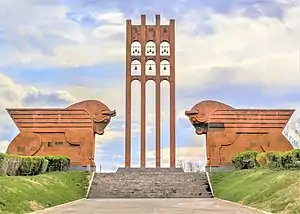 Sardarapat Memorial (1968)
Sardarapat Memorial (1968) Nor Hachn Memorial (1974)
Nor Hachn Memorial (1974)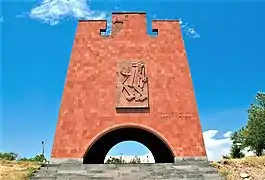 Musa Dagh (Musa Ler) Memorial (1976)
Musa Dagh (Musa Ler) Memorial (1976)_-_panoramio.jpg.webp) Bash-Aparan Memorial (1979)
Bash-Aparan Memorial (1979)
Religious
Israyelian designed two altars for Etchmiadzin Cathedral, Armenia's mother church: the Main Altar (1958) and the Altar of Descent (1962).[17][15][7]
In 1972 the summer residence of the Catholicos of All Armenians, known as "Haykashen", was built in Byurakan according to Israyelian's design.[18][7]
Israyelian designed several Armenian churches both in Armenia and abroad. In Yerevan he designed reconstructions of two churches: St. Sargis and Saint John the Baptist. Both were completed after Israyelian's death. St. Sargis, which was entirely reconstructed, was completed in 1976.[15] Architect Artsrun Galikyan further contributed to the design after Israyelian's death.[19] The reconstruction of Saint John the Baptist church, designed by Israyelian, was completed in the 1980s. The reconstruction works were further developed by Baghdasar Arzoumanian and engineer Avetik Teknejian.[20]
Israyelian designed and co-designed three churches in the Armenian diaspora: Holy Forty Martyrs Church in Milan, Italy (1958), St. Vartan Armenian Cathedral in New York City (1968),[21] and Surp Nerses Shnorhali Cathedral in Montevideo, Uruguay (1968).[15][22] The church in Milan was co-designed with Armenian-American architect Zareh Sourian,[23][24] while the church in Montevideo with Varazdat Harutyunyan.[25]
St. Vartan is the first Armenian cathedral built in the US.[26] It is based on classical Armenian church architecture,[27] namely Saint Hripsime Church in Ejmiatsin.[28] According to some sources, it was designed by Walker O. Cain,[29] however, the Armenian church publication indicates Israyelian as its architect.[30] Varazdat Harutyunyan noted that Israyelian designed was only modified slightly.[5] According to the website dedicated to Israyelian, it was designed by Israyelian, but because he could not travel to the US, its construction was supervised by Édouard Utudjian.[31]
 Forty Martyrs Church in Milan (1958)
Forty Martyrs Church in Milan (1958)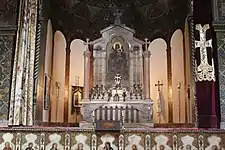 Main Altar of Etchmiadzin Cathedral (1961)
Main Altar of Etchmiadzin Cathedral (1961)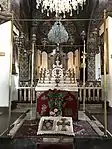 Altar of Descent of Etchmiadzin (1961)
Altar of Descent of Etchmiadzin (1961)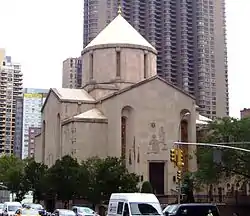 St. Vartan, New York (1968)
St. Vartan, New York (1968)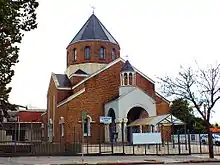 St. Nerses Shnorhali, Montevideo (1968)
St. Nerses Shnorhali, Montevideo (1968)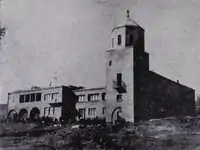 Haykashen (1971)
Haykashen (1971).jpg.webp) St. Sargis, Yerevan (1976, reconstruction)
St. Sargis, Yerevan (1976, reconstruction)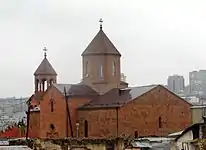 St. John the Baptist (1980s, reconstruction)
St. John the Baptist (1980s, reconstruction)
Monuments
Israyelian designed two structures at Victory Park in Yerevan. The first is the pedestal for the statue of Stalin, which has served as a museum of "Great Patriotic War" (World War II). It was completed in 1950. It is now also the pedestal of the monument Mother Armenia.[15] The second is the main entrance to the same park, completed a decade after his death, in 1982.[15]
Israyelian designed several popular monuments near prominent landmarks of Armenia. In 1957 "Eagle of Zvartnots", created with Yervand Kochar, near the 7th century Zvartnots Cathedral.[6][32] In the same year, on a small hill on the road to the temple of Garni, a monument known as the "Arch of Charents" was erected. It offers a panoramic view of Mount Ararat. It is often referred to as the "Arch of Ararat". Lines from a Yeghishe Charents poem glorifying the mountain are inscribed into the monument.[6] The "Lion of Geghard" was erected near the monastery of Geghard in 1958.[6] It was sculpted by Ara Harutyunyan.[6] The monument is inspired by the coat of arms of the Proshian noble family found inside Geghard.[8]
In 1960 a monument conventionally known as the "Western Entrance of Yerevan" was erected in the outskirts of Yerevan, facing those entering the capital from the direction of Vagharshapat (Ejmiatsin).[15]
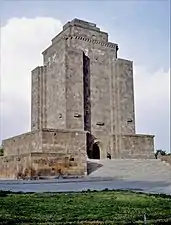 Museum of World War II
Museum of World War II Eagle of Zvartnots (1957)
Eagle of Zvartnots (1957) Arch of Charents (1957)
Arch of Charents (1957).JPG.webp) Lion of Geghard (1958)
Lion of Geghard (1958)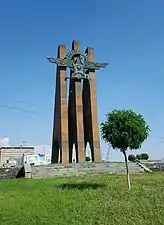 Western Entrance of Yerevan (1960)
Western Entrance of Yerevan (1960).jpg.webp) Entrance of Victory Park (1982)
Entrance of Victory Park (1982)
Other buildings
Israyelian designed a number of structures and buildings for civic use. They include the Ararat Wine Factory in Yerevan (1937–1961);[15] the Kheres Wine Factory in Oshakan (1950s);[15] the Hrazdan Gorge Aqueduct in Yerevan (1950), with engineer G. Yeghoyan;[6] Government House #2 in Yerevan's Republic Square (1955, with Samvel Safaryan and Varazdat Arevshatyan),[33][34][35] the building of the Union of Artists of Armenia in Yerevan (1955-56);[15] the Ethnographic Museum of Armenia near the Sardarapat Memorial (1977–78).[6] His design for Kevork Chavoush Museum in Ashnak village was completed in the 1980s.[8]
He also designed restaurants in Yerevan ("Aragil, 1957/1060),[6][15] Hrazdan ("Tsovinar", 1960),[15] and Vanadzor ("Kars", 1965).[15] Israyelian designed decorative drinking fountains at the courtyards of St. Hripsime (1958), Geghard (1958/59), Etchmiadzin Cathedral (1967), St. Gayane (1972),[17] and in numerous villages and towns around Armenia (1943–46), including Parakar, Karbi, Stepanavan, Sisian, Byurakan, Artik, Goris, Ashtarak, Alaverdi, and Taperakan.[15]
He also designed the Kanaker Aluminium Plant (KanAZ) buildings (1948–50), a campus of the Yerevan Physics Institute on the slopes of Mount Aragats (1960), a large hotel (pansionat) in Sochi, Russia (1977), several residential buildings in Yerevan and other structures.[15]
 Hrazdan Aqueduct (1950)
Hrazdan Aqueduct (1950) Government House #2
Government House #2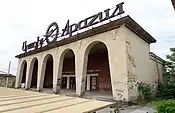 Aragil Restaurant (1957-60)
Aragil Restaurant (1957-60).jpg.webp) Union of Artists of Armenia (1956)
Union of Artists of Armenia (1956)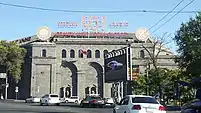 Ararat Wine Factory (1937–1961)
Ararat Wine Factory (1937–1961)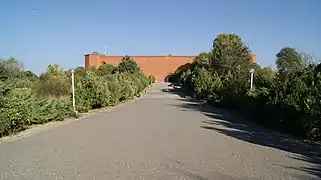 Ethnographic Museum of Armenia (1978)
Ethnographic Museum of Armenia (1978)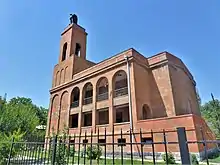 Kevork Chavoush Museum (1980s)
Kevork Chavoush Museum (1980s)
Legacy
Martiros Saryan and Artashes Hovsepyan created portraits of Israyelian. Grigor Khanjyan depicted him in the mural Revived Armenia (1999-2000).[36] A street in Yerevan was named after him.[37]
In mid-2000s Israyelian's son Vahagn proposed to turn the second floor of Israyelian's house at 9 Saryan St. in Yerevan into a house-museum.[38] The house, designed and built by himself, was demolished in October 2011 to make way for a hotel.[39] The Municipality of Yerevan stated that Israyelian's son, Vahagn, had sold the house earlier and gave formal permission to demolish it.[40]
Awards
- USSR State Prize (1951)
- Honored Artist of Armenian SSR (1961)
- Honored Architect of Armenian SSR (1968)
- People's Architect of the USSR (1970)
- Military awards[2]
References
- Dolukhanian 2008, p. 119.
- "Կյանքն ու հասարակական գործունեությունը [The Life and Social Activities]". rafaelisraelyan.com (in Armenian). Archived from the original on 2018-01-20.
- Ryabushin, Alexander; Smolina, Nadia (1992). Landmarks of Soviet architecture, 1917-1991. Rizzoli. p. 74. ISBN 978-3433023341.
- "Տարեգրություն [Biography]". rafaelisraelyan.com (in Armenian). Archived from the original on 2018-02-06.
- Harutiunian 1978, p. 87.
- Babayan, L. (1978). "Իսրայելյան Ռաֆայել [Israyelian Rafayel]". Soviet Armenian Encyclopedia Volume 4 (in Armenian). pp. 419-420.
- Editoral (1973). "Մահ ճարտարապետ Ռաֆայել Իսրայելյանի (1908-1973)". Etchmiadzin. 30 (9): 41–43.
- Dolukhanian 2008, p. 120.
- Harutiunian 1978, p. 83.
- Architecture + Design, 1988, vol. 5, p. 25 "Rafael Israelyan. He has developed links with the Armenian tradition by drawing upon its origins which are close to ancient Assyrian forms"
- Adalian, Rouben Paul (2010). Historical Dictionary of Armenia. Lanham, Maryland: Scarecrow Press. p. 96. ISBN 978-0-8108-7450-3.
- part 1, part 2
- Israyelian, Rafayel (1965). "Մեծ եղեռնի հուշարձանի իմ մտահղացումը [My idea for genocide memorial]". Etchmiadzin (in Armenian). 32 (11–12).
- "Memorial in Tokhmakh neighborhood of Yerevan, Armenia". armenian-genocide.org. Armenian National Institute.
- "Կառույցների ցանկ [List of buildings]". rafaelisraelyan.com (in Armenian). Archived from the original on 2018-02-16.
- Editorial (1968). "Սարդարաբադի հերոսամարտի հիշատակին նվիրված զբոսայգի-հուշարձանի բացումը". Etchmiadzin (in Armenian). 24 (6): 41–43.
- Harutiunian 1978, p. 90.
- Hasratyan, Murad (2008). "Վազգեն Ա Ամենայն Հայոց Կաթողիկոսի վերանորոգչական-եկեղեցաշինական գործունեությունը [Reconstructive and Church building activity of Vasken I, Catholicos of All Armenians]". Etchmiadzin (in Armenian). 64 (10): 54.
Դրանց շարքում կարևոր է Մայր Աթոռի միաբանների ու Հոգևոր Ճեմարանի սաների հանգստի համար նախատեսված՝ Բյուրականի ‹‹Հայկաշեն›› անվանված ամառանոցը, որի կառուցումն ավարտվեց 1972 թ. (ճարտ. Ռ. Իսրայելյան):
- Hatitian, Artun; Shahbazian, Pargev (1976). "Երևանի ս. Սարգիս վերակառուցված առաջնորդանիստ եկեղեցու նավակատիքն ու օծումը". Etchmiadzin (in Armenian). 33 (10–11): 90.
...այս երկու ճարտարապետների՝ Ռաֆայել Իսրայելյանի և Արծրուն Գալիկյանի նախագծով...
- "Սբ. Հովհաննես Մկրտիչ եկեղեցի [St. John the Baptist Church]". yerevan.am (in Armenian). Yerevan Municipality.
- Dugan, George (29 April 1968). "Armenian Patriarch Consecrates Cathedral Here". The New York Times.
- Dolukhanian 2008, p. 121.
- "About Us". chiesaarmena.org. Chiesa Apostolica Armena d'Italia. 2013. Archived from the original on 18 April 2019.
Now the only functioning church in Milan is the Church of S. Forty Martyrs, built in 1957 (architects R.Iisraelian, P. Suryan), the church was consecrated in 1958.
- Editorial. "Միլանոյի հայոց Սրբոց Քառասնից Մանկանց եկեղեցու օծումը". Etchmiadzin (in Armenian). 12 (12): 40–42.
Եկեղեցու ճարտարապետն է ամերիկահայ պր. Զարի Սուրյանը։
- Harutyunyan, Varazdat (1995). "Ծառայություն գահակալներին". Etchmiadzin (in Armenian). 52 (2–3): 131.
էլ ավելի ընդարձակելով աշխարհագրական սահմանները, հայրենիքի փորձառու ճարտարապետների միջոցով էսքիզային նախագծեր տրամադրվեցին Նյու֊Յորքի Սուրբ Վարդան (հեղինակ Ռաֆայել Իսրայելյան), Վիեննայի (հեղինակ էդվարդ Սարապյան), Միլանի (հեղինակ Ռաֆայել Իսրայելյան) և Մոնտեվիդեոյի (հեղինակներ Ռաֆայել Իսրայելյան և Վարազդատ Հարությունյան) եկեղեցիների կառուցման համար:
- "Armenian Church Focuses on Schism". The New York Times. 7 May 1973.
- Blau, Eleanor (11 September 1981). "New Yorkers Reap Harvest of Autumn Fairs". The New York Times.
- "May 5 Concert To Honor 50 Years of St. Vartan Cathedral". armenianchurch.us. Eastern Diocese of the Armenian Church of America. 1 April 2018.
Even while it was under construction, he could see that St. Vartan Cathedral was modeled “along the lines of the 7th-century St. Hripsime Church in Armenia...
- "23-Karat Gold Leaf; Dome of Armenian Cathedral Is Regilded". The New York Times. 5 December 1993.
- Editorial (1982). "Հայագիտական հրատարակություններ [Publications on Armenian Studies]". Etchmiadzin (in Armenian). 39 (11–12).
- "Նյու-Յորքի Սբ. Վարդան եկեղեցի". rafaelisraelyan.com (in Armenian). Archived from the original on 2018-06-07.
- "Փորձ է արվում նսեմացնել Երվանդ Քոչարի ստեղծագործական ժառանգությունը". am.am (in Armenian). AM Law Firm. 11 February 2016. Archived from the original on 11 April 2019.
- Government of the Republic of Armenia (2 November 2004). "Հայաստանի Հանրապետության Երևան քաղաքի պատմության և մշակույթի անշարժ հուշարձանների պետակական ցուցակ [List of historical and cultural monuments of Yerevan]". arlis.am (in Armenian). Armenian Legal Information System. Archived from the original on 5 August 2016.
վարչական շենք. Կառավարական երկրորդ տունը, 1955 թ., Ճարտ.` Ս. Սաֆարյան, Ռ. Իսրայելյան, Վ. Արևշատյան
- "Սամվել Սաֆարյան վաստակավոր ճարտարապետ [Samvel Safaryan]". archmuseum.am (in Armenian). National Museum-Institute of Architecture of Armenia.
...Կառավարական 2-րդ շենքը Երևանի Հանրապետության հրապարակում (համահեղինակներ՝ Ռ.Իսրաելյան, Վ.Արևշատյան)...
- Gevorgian, A. O. (1979). "Yerevan". The Great Soviet Encyclopedia.
The main architectural ensemble of the city is Lenin Square, at which several streets converge. On the square are a monument to V. I. Lenin (cast bronze, 1940, sculptor S. D. Merkurov), the Government House of the Armenian SSR (1926-41, A. I. and G. A. Tamanian), the second Government House (1955, S. A. Safarian, V. A. Arevshatian, and R. S. Israelian), the Armenian Historical Museum (1975), the Hotel Armenia (1958), and the building of the Communications Ministry and the Trade Union Council (1956-58); the last three were designed by M. V. Grigorian and E. A. Sarapian.
view article online - "Իսրայելյանը նկարինչների նկարներում". rafaelisraelyan.com (in Armenian). Archived from the original on 2018-03-22.
- "Streets of Yerevan of municipal significance" (PDF). yerevan.am (in Armenian).
- Hakobyan, Gohar (25 June 2004). "Թանգարանի ոդիսականը". Aravot (in Armenian). (archived)
- "Prominent Armenian architect's house demolished in Yerevan (video)". Tert.am. 10 October 2011.
- "Երեւանի քաղաքապետարան. Ռաֆայել Իսրայելյանի որդին համաձայնություն է տվել առանձնատան տեղում բազմաֆունկցիոնալ շենքի կառուցմանը". mediamax.am (in Armenian). 11 October 2011. Archived from the original on 12 April 2019.
- Bibliography
- Dolukhanian, Lola (2008). "Ռաֆայել Իսրայելյան. ստեղծագործության և իր մասին [Raphael Israelian: On him and his works]". Etchmiadzin. 64 (10): 118–122.CS1 maint: ref=harv (link)
- Harutiunian, Varazdat (1978). "Տաղանդաշատ ու հայրենաշունչ (ճարտարապետ Ռաֆայել Իսրայելյանի ծննդյան 70-ամյակի առթիվ". Etchmiadzin. 35 (8–9): 82–90.CS1 maint: ref=harv (link)
- Further reading